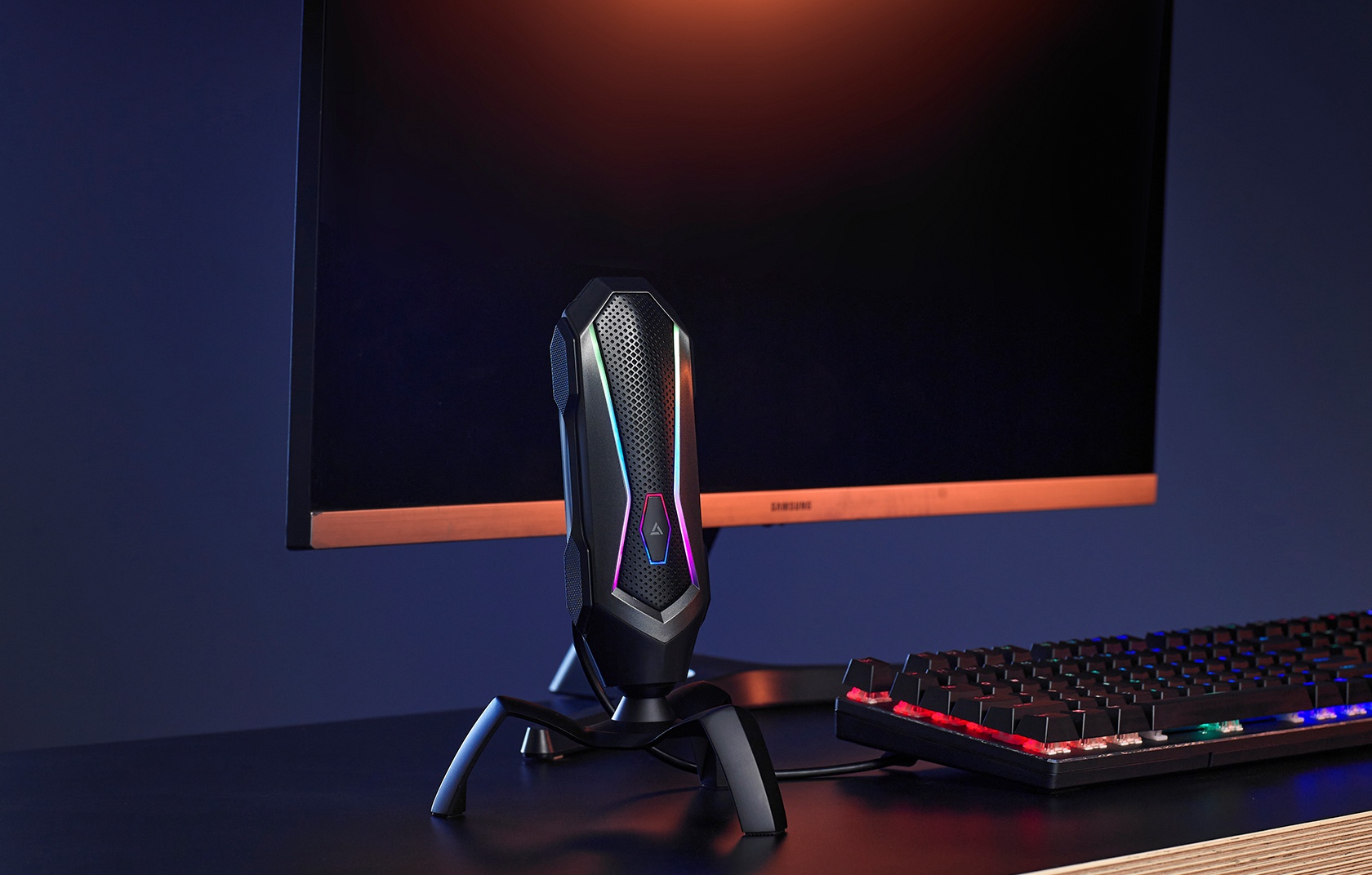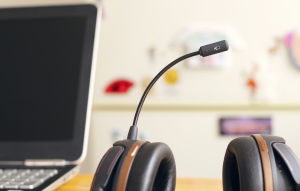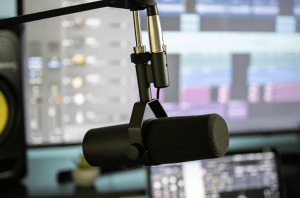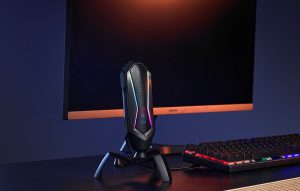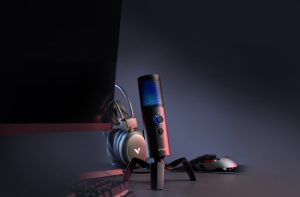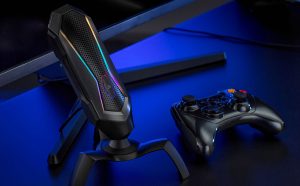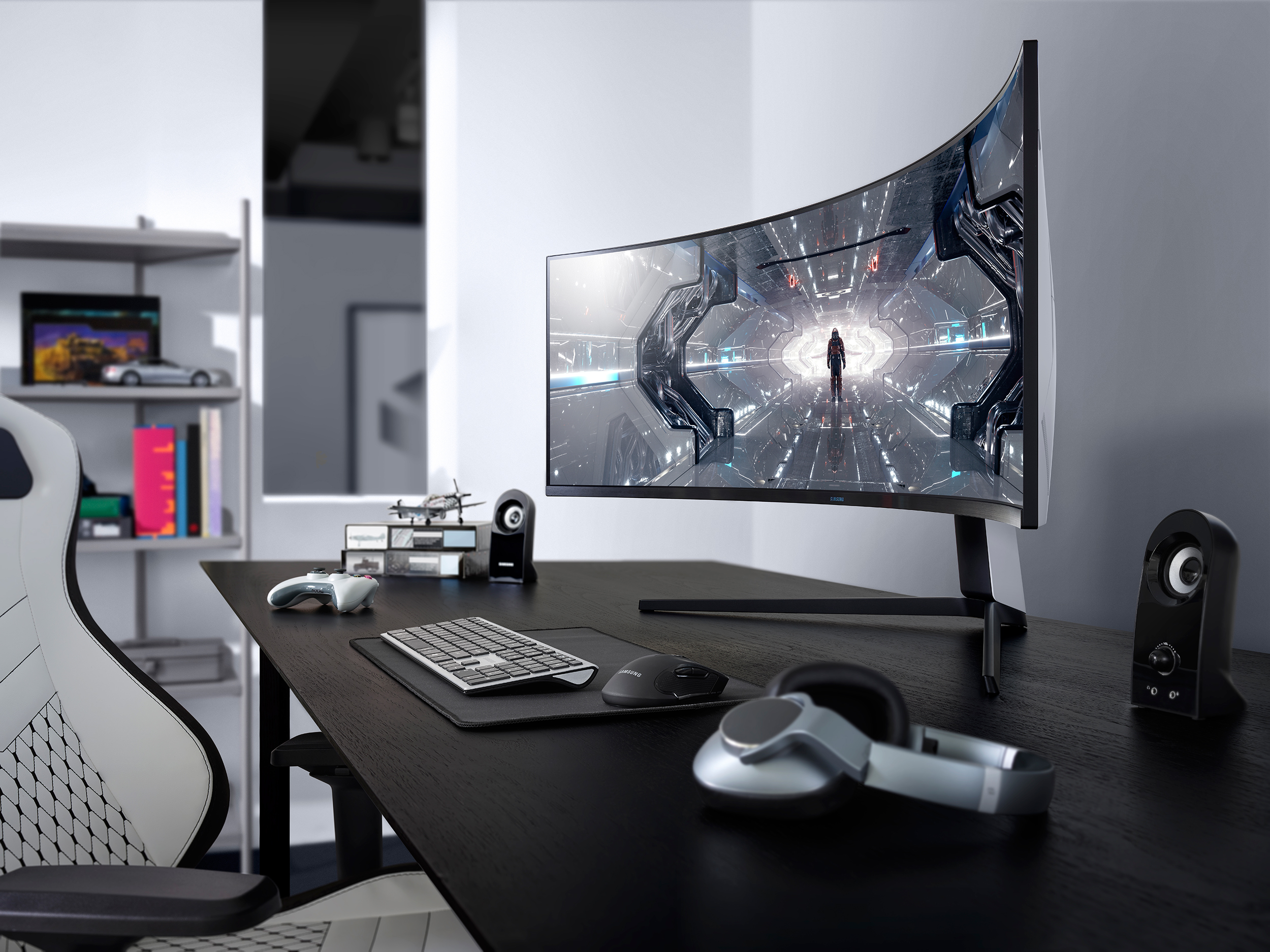- Is the microphone on my headset good enough?
- Analog or Digital? XLR or USB?
- How are XLR microphones different from USB microphones?
- When are analog microphones useful?
- Omni-directional capabilities: The most important benefit of USB microphones for streaming
- USB microphones for gamers recommendations
- Rapoo VS300 Heart-shaped Cardioid gaming microphone
- Rapoo VS500 Dual-Point gaming microphone
Getting into streaming can seem daunting for newcomers. There are so many things you need to be aware of: background lighting, the number of RGB peripherals in the shot, and your skills in the game you play while streaming. All of this needs to be taken into account to grab the attention of viewers scrolling through Twitch, giving streamers only a few seconds to impress them before jumping on to the next. More important than the lighting and the framing, however, are your video and audio.
If the webcam and the microphone you are using aren’t up to par, it wouldn’t matter how many dynamic LED panels you have on the wall or how sick your RGB gaming headset looks. This is why streamers often pay a premium to purchase the best microphone for gaming or the top webcam for streaming. Make sure you have taken care of these two before you jump on to spending time and resources on making your setup look nicer. Without great audio and video, nothing else matters.
In this article, we will focus on the audio aspect of your stream and what features you should consider as you look for the best microphone for streaming gaming content.
Is the microphone on my headset good enough?
Most of the time, not really. If you’ve spent any amount of time in a competitive gaming lobby, you have probably heard the term potato. It is typically used when the lobby hears someone speaking into a microphone which almost seems like is in their mouth, making it very difficult to listen to them. The issue might be caused by excessive gain on the microphone, causing extreme audio compression. However, it is more than likely due to the their headset microphone not having the capability to deliver decent audio.
As a general rule of thumb, using headset microphones for streaming is not appropriate as they do not provide decent audio until proven otherwise. This is mainly due to the minimal space available in the enclosure to put in the microphone components. Even lavalier microphones typically have a bigger housing for the internals than most gaming headset boom microphones. In an extreme scenario, this results in tinny-sounding audio that is all treble and no bass, accentuating the harsh “S” and “P” sounds that annoy every listener.
The problem with headset microphones does not exist in stand-alone microphones as they have all the space they need to fit whatever components are necessary to get decent audio coming from all angles. This is why you should seriously consider purchasing a dedicated microphone for streaming if you want your viewers to experience pleasant audio.
Analog or Digital? XLR or USB?
These two questions are essentially the exact same––just worded differently. Analog microphones can also be referred to as studio microphones. A number of podcasters also use studio microphones. They come in several shapes, but if you need help visualizing what a studio microphone looks like, think of the NeuMan U87 in a recording studio, the Shure SM7b in your favorite podcast, or the Shure SM58 in the hands of your favorite singer live on stage.
How are XLR microphones different from USB microphones?
To know the fundamental difference between the two types of microphone, we need to get slightly technical about how a microphone signal works.
When audio is picked up by any microphone, the signal is incredibly weak and needs to be boosted. This is true for all microphones, below AED 200 or over AED 2000. The primary difference between analog and digital microphones is how the signal boosting is handled.
In digital/USB microphones for streaming (or other purposes), the signal is boosted through the pre-amp that already exists in the enclosure. However, there is no signal boosting in analog microphones. Signal boosting needs to be handled by a separate device, typically a soundcard with built-in preamplifier, for it to be usable. This analog signal that is now boosted needs to be turned digital for the computer to use. That process is carried out by a sound card that connects to the microphone via an XLR input (an analog port) and transfers the now-digital signal to the computer via USB.
If you want to use analog microphones, you need to also get a separate sound card, whereas with USB microphones, the mic itself is the only thing you need to start getting usable signals from it.
When are analog microphones useful?
Studio microphones are typically uni-directional (also referred to as cardioid). Cardioid microphones are great for studios as they pick up sound from only one direction and naturally cancel out any sound that comes from other directions. They also only pick up audio from a very short distance. These features make them excellent for performers/singers who are trained to work with the intended limitations of cardioid microphones. Microphones are the tools that singers manipulate to give them the intended sound.
In podcasts, the benefit is, once again, the removal of background noise and an emphasis on the voice of the speaker that is coming only from one direction. In podcasts though, it can be slightly less desirable to use studio microphones (this is why you will find podcasts that use USB microphones) as it can be annoying at times for speakers to constantly have to adjust the microphone stand to be as close to their mouth as possible.
Omni-directional capabilities: The most important benefit of USB microphones for streaming
USB mics generally end up being much cheaper than analog/studio mics because you won’t need to buy a separate sound card with the microphone. But there are also other, more nuanced benefits that make USB mics a better option for streamers in particular.
Firstly, USB microphones are almost always omni-directional, meaning they can pick up audio from all directions. This is one of the reasons why they are the best microphones for streaming. Unlike analog microphones, USB microphones pick up audio not just from all directions, removing the need for orienting the audio source towards it.
Secondly, USB microphones pick up audio from much farther away. This means that you can set the USB microphone on the desk and not even think twice about repositioning it or yourself to get decent input. This is almost essential if you are playing competitive games on stream and cannot afford to focus on the position of the microphone and constantly adjusting it for the best audio experience.
Thirdly, USB mics are designed with streamers in mind, so they fit much more nicely in an RGB setup than any studio mic ever will. If you care about aesthetics at all, USB models are the best microphones for gaming.
Note that because USB microphones pick up audio from all directions and great distances, the natural background noise cancellation of cardioid microphones doesn’t happen in USB mics. USB microphones need to handle background noise through post-processing, to varying qualities, which depends on the manufacturer’s noise-cancellation algorithms.
USB microphones for gamers recommendations
Now that we have established that USB mics are the way to go to improve your streaming audio, let us take a look at two newly released options by Rapoo, one of the biggest suppliers of budget-friendly gaming peripherals in the region. Their new offerings have the potential to become some of the best mics for gaming on the market.
Rapoo VS300 Heart-shaped Cardioid gaming microphone
The most striking feature of this desktop microphone for streaming is its design. The RGB lighting, combined with the spaceship-like shape and spider-legs, makes the Rapoo VS300 a definite looker on your desk.
The good design choices don’t end there. The base allows the microphone to rotate 360 degrees, which comes in handy, especially when you use the “heart shaped” pick-up pattern. This is essentially another name for the cardioid pickup pattern, which means the microphone is picking up voice from one direction and cancelling out the others. Since the VS300 also features omni-directional voice input, the heart-shaped pickup is enabled by software, not the hardware of the microphone.
There are two scenarios in which using the heart-shaped pickup pattern can make a slight improvement to your streaming setup: (1) if you have a lot of background noise coming from behind your streaming setup; and (2) if you want the audio signal to weaken when you move or turn your head while you speak to make it more difficult to hear. They are rather niche scenarios and it might generally be better to just use the omni-directional mode. But it’s great that Rapoo is giving us more options.
The final point about the design is the semi-customizable nature of the RGB lighting. There is a single button on the microphone that cycles between the different RGB presets to make it fit your setup. Speaking of customizability, the VS300 has a USB-C port in the back for maximum compatibility with modern computers. It also comes with a decently long 1.8m UBS-C to USB-A cable to connect to your computer.
The Rapoo VS300 is a Rapoo product that offers great value for the money. It is an entry level stand-alone microphone fit to help step up your stream audio quality. Rapoo’s first foray in this category has the potential to be one of the best microphones for streaming at its price point.
Rapoo VS500 Dual-Point gaming microphone
The bigger brother of the VS300 adds a good few extra features and comes in a sleeker, more subtle looking package. The VS500 still features RGB lighting, but it is more restrained as it is covered by metal grills on top of the microphone.
There are some extra neat features to make it worth the extra premium when compared to the VS300. It features a 3.5mm audio output so you can connect your earphones/headsets to the microphone and monitor the recorded signal in real-time while also getting the audio feed from your computer. It also has a knob to switch between the two different audio pickup patterns: cardioid (heart shaped) and omni-directional. In the box, you will also find a pop filter that you can pop on the mic to avoid harsh “S” or “P” sounds.
The VS500 features a built in shock absorber with the same spider-leg looking tripod that comes attached to it. It also has the same USB-C out as the VS300 and the 1.8m USB cable. It does come at a steeper price point than the VS300, but the main reason for that is due to the real-time monitoring feature that can prove really valuable at times, making the VS500 a great microphone for streaming.
Final thoughts
It remains to be seen whether Rapoo can replicate the success of its other VPRO gaming peripherals with their new line-up of VSX00 dedicated microphones. But if experience is anything to go by, Rapoo will be claiming a chunk of this market, especially the more budget options, just like it has before. We don’t see why it can’t as the new offerings on display can stand on their own two feet…or three feet in this case!
Interested in learning more about Rapoo products?
As an official Rapoo distributor in the Middle East, Newcom offers a wide range of Rapoo products, including the VS300 and VS500.
If you are interested in any of the products discussed in this article, please make sure to check out our products page. For further information or any inquiries, make sure to directly call us or reach out through our Contact Us page.
To make sure you are the first to find out about the latest Rapoo releases in the region, be sure to frequently check out our blog posts.
